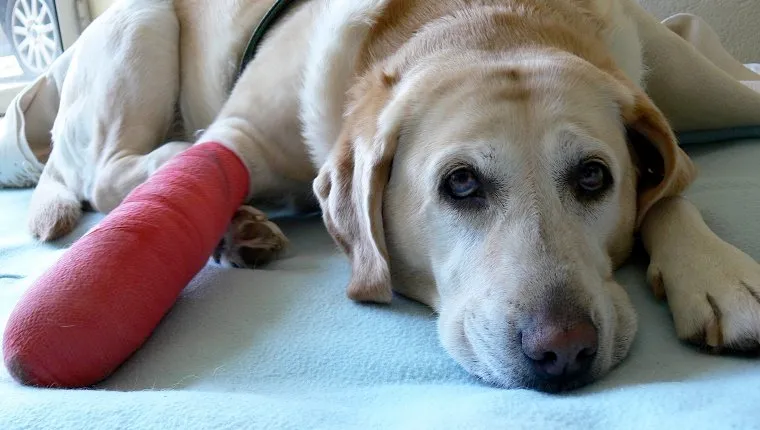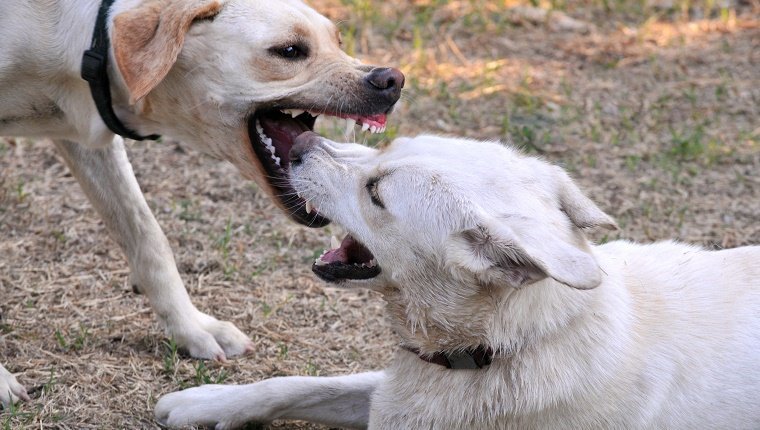One of our DogTime fans has questions for Dear Labby about her two pups who sometimes have bad fights. She writes:
Dear Labby,
I have two dogs who mostly get along as siblings. They lie down together, play with each other, and don’t show any signs of jealousy when I’m giving attention to one or the other.
The boys are almost always fine and well-behaved together, but sometimes they fight. Bad fights.
They have their normal day-to-day sibling squabbles, but on rare occasions, it just gets out of hand. One time one of the pups even needed stitches for a pretty bad bite wound.
What should I do to keep them from going overboard and attacking each other?
Signed,
Brothers’ Infighting Turns Evil
Dear Labby Has The Answer!

Dear B.I.T.E.,
Having fur kids who fight can be a scary thing. Early socialization and training in puppyhood will decrease aggression and instances of fighting, but if you’ve adopted dogs who’ve passed that age, the ship has sailed. Adult dogs do benefit from socialization, but it’s not as effective as it is for puppies.
Some might suggest that you simply get rid of one of your precious pooches, but they don’t understand the deep bond that you have with your dogs and the bond that your pups likely have with each other, despite the bites.
You wouldn’t suggest that someone give up one of their children just because he hit his sister.
However, like with human children, there are things you can do to curb the infighting between your dogs, things you can do to prevent a fight from breaking out at all, and things you can do to stop a fight that’s already started.
Here’s some advice on how to handle pooches who get nasty to each other before the situation escalates beyond your control.
Exercise More

One of the main factors in household dog aggression is stress, and being stuck inside with each other with nothing to do can cause a good deal of stress.
You may notice more conflicts in winter months when the pups are stuck inside for longer periods of time.
It’s important to find some sort of exercise and physical stimulation. Tired dogs are less likely to have energy to fight, and they’ll feel less confined and anxious.
Separate Resources

If you give one of your dogs a chew toy or bone, make sure the other pup has their own item to chew on in a separate space. A lot of conflicts are caused by dogs defending their resources, as well as miscommunication about intent.
For example, lets say one of your pups is sitting alone chewing a bone. The other dog approaches. Dog with the bone gives a warning. Other dog has no interest in the bone and is just passing by, but dog with the bone takes that as a sign that his resource is in danger of being taken away, and a fight breaks out.
Give your dogs separate spaces to eat, sleep, or enjoy their own possessions in peace.
Check For Signs Of Pain

If one of your dogs has an injury, arthritis, or medical condition that’s causing pain, it could cause them to become overly protective.
They may snap at another dog who approaches because they’re worried that they’ll get hurt if they’re touched.
Take a trip to the vet if one of your pups has some tender areas that they’re defending more than usual.
Recondition Behavior

If your dogs react badly to each other’s presence, it may be time to consult a professional behaviorist.
You will likely have to retrain your dogs to associate positive experiences and rewards with being near each other. This is a long process, and you’ll need to keep at it.
In the long run, it will be the best option for getting your dogs to be comfortable around one another.
Read Body Language

Dogs rarely fight without giving visible cues through their body language that they’re upset.
Look for stiff body movements, a rigid tail pointing straight up or down, a hard, unwavering stare, or teeth showing. These are signs that a dog is ready to rumble, so it’s time for you to intervene before things get out of hand.
Block The View

Use whatever obstructions you have in your home to block the dogs from seeing each other. Break their eye contact.
You can toss a blanket over one of the dogs, hold a pillow between them, or move one of them to another room or behind a piece of furniture if it’s safe to do so.
Some dog parents have an umbrella handy, as opening it causes a distraction that can break your dogs’ focus and provide a barrier to put between them. Others use a baking sheet because it’s hard and you can bang on it to create another distraction.
Any object that breaks their concentration can work.
Water, Sprays, & Deterrents

Water is always a good way to cool things down. Some dog parents have a water gun or spray bottle handy to startle their pups and get their attention away from each other.
Citronella sprays are harmless to dogs, but they produce an odor that they find unpleasant, and it will distract them enough to deescalate a fight. Others suggest a vinegar spray that has similar results.
Spraying a garden hose can work if tensions rise in the backyard, as well.
Wheelbarrow Legs

If things are escalating and a fight is breaking out, you can grab the aggressor dog by the hind legs and tail and lift until the dog is in the wheelbarrow position.
This can be quite dangerous, as the dog may turn on you and bite without thinking. It’s best to break up the fight and move away as quickly as possible.
Some dog parents suggest twisting the back legs to force the dog onto their back in the submissive position. Again, it’s a move that involves some risk, but when your dogs’ safety is at stake, it may be worth it.
Under no circumstances should you put your hands in or near a fighting dog’s mouth. You are likely to get a serious bite wound that can easily get infected.
So, B.I.T.E., I hope that gives you some ideas on how to help stop the fighting between the doggy brothers in your home.
Keep in mind that re-homing one of your dogs is still an option, even though it may break your heart to do so. It would be even more heartbreaking if one of your dogs got seriously injured. Be responsible and do the right thing for your pups, and you’ll be fine.
Do your dogs ever get into bad fights? Got a question for Dear Labby? Let us know in the comments below!









